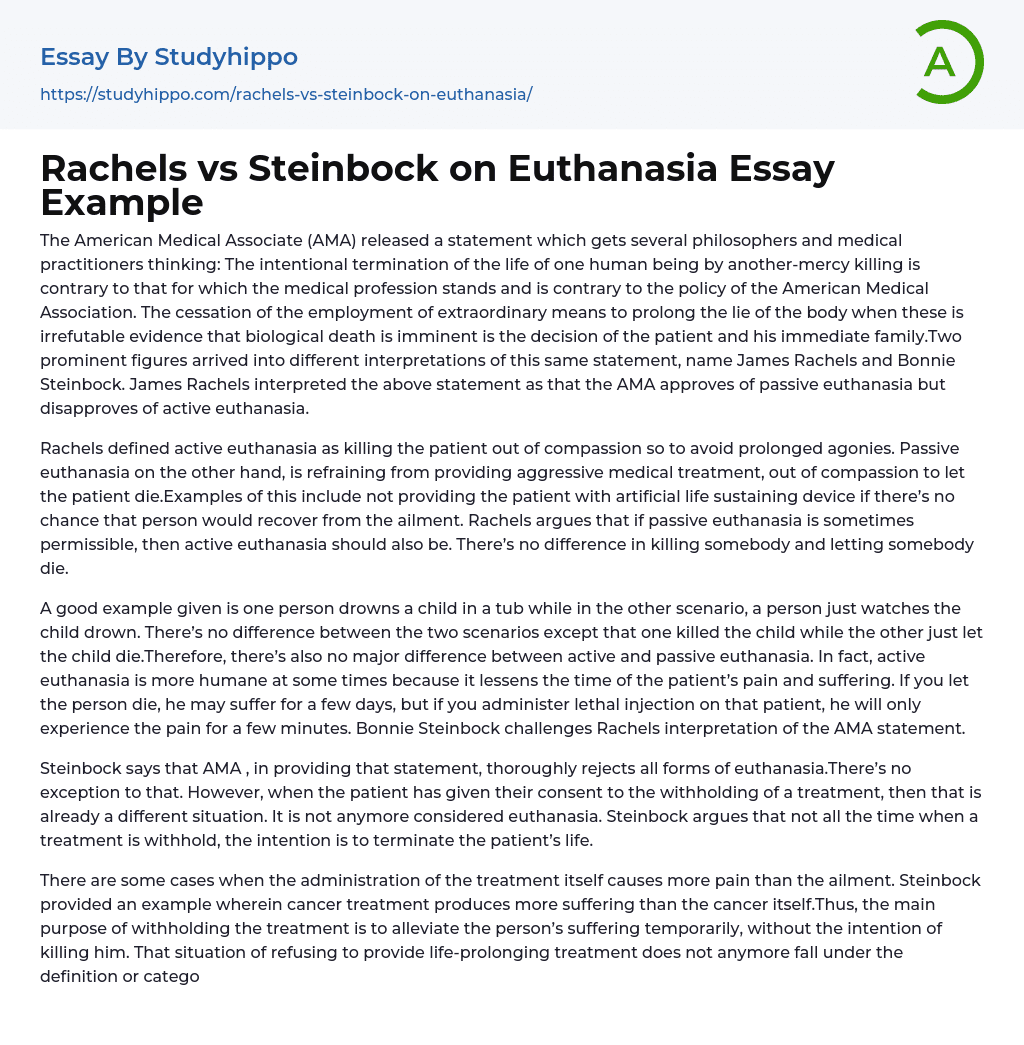The American Medical Associate (AMA) released a statement which gets several philosophers and medical practitioners thinking: The intentional termination of the life of one human being by another-mercy killing is contrary to that for which the medical profession stands and is contrary to the policy of the American Medical Association. The cessation of the employment of extraordinary means to prolong the lie of the body when these is irrefutable evidence that biological death is imminent is the decision of the patient and his immediate family.Two prominent figures arrived into different interpretations of this same statement, name James Rachels and Bonnie Steinbock. James Rachels interpreted the above statement as that the AMA approves of passive euthanasia but disapproves of active euthanasia.
Rachels defined active euthanasia as killing the patient out of compassion so to avoid prol
...onged agonies. Passive euthanasia on the other hand, is refraining from providing aggressive medical treatment, out of compassion to let the patient die.Examples of this include not providing the patient with artificial life sustaining device if there’s no chance that person would recover from the ailment. Rachels argues that if passive euthanasia is sometimes permissible, then active euthanasia should also be. There’s no difference in killing somebody and letting somebody die.
A good example given is one person drowns a child in a tub while in the other scenario, a person just watches the child drown. There’s no difference between the two scenarios except that one killed the child while the other just let the child die.Therefore, there’s also no major difference between active and passive euthanasia. In fact, active euthanasia is more humane at some times because it lessens the
time of the patient’s pain and suffering. If you let the person die, he may suffer for a few days, but if you administer lethal injection on that patient, he will only experience the pain for a few minutes. Bonnie Steinbock challenges Rachels interpretation of the AMA statement.
Steinbock says that AMA , in providing that statement, thoroughly rejects all forms of euthanasia.There’s no exception to that. However, when the patient has given their consent to the withholding of a treatment, then that is already a different situation. It is not anymore considered euthanasia. Steinbock argues that not all the time when a treatment is withhold, the intention is to terminate the patient’s life.
There are some cases when the administration of the treatment itself causes more pain than the ailment. Steinbock provided an example wherein cancer treatment produces more suffering than the cancer itself.Thus, the main purpose of withholding the treatment is to alleviate the person’s suffering temporarily, without the intention of killing him. That situation of refusing to provide life-prolonging treatment does not anymore fall under the definition or category of euthanasia, since it does not necessarily equate to letting the patient die.
Steinbock does not differentiate active and passive euthanasia. Instead, he maintains the distinction of ordinary from extraordinary treatment. Ordinary treatments are the medical means a doctor is normally expected to provide to his patient.Extraordinary treatments are those painful treatments but with very little chance of success.
It is a requirement to provide patients with ordinary care, failing to do so is neglect of responsibility or homicide. If a patient has requested not to receive these extraordinary treatments, the doctors are
left with no option but to follow. Not providing extraordinary treatment is not punishable. Rachels’ and Steinbock’s interpretations are well founded upon, and thus have their own strong points.
I don’t think I am in the best position to tell who have the most accurate interpretation of AMA’s statement.Only AMA can tell what they exactly mean by their statement. I feel that AMA’s statement has been vaguely written. They were not able to provide exact and specific definitions of the words they used. I couldn’t blame Rachels and Steinbock for arriving at very different interpretations of AMA’s statement.
But if I need to give out my personal opinion on this subject, I’d go with Steinbock’s interpretation. I don’t think AMA would want their statement interpreted like what Rachels did. Because if that’s the case, then the two sentences in the above statement are obviously not consistent.The first statement says they don’t approve of any forms of mercy killing as they are contrary to what the principles of their medical profession says. But the second statement directly contradicts the first by saying that the decision lies with the patient or his immediate family. The only time both statements would become consistent is if that decision to die referred in the second statement does not fall into the same category as euthanasia, just like what Steinbock interprets.
I know, it’s rather more of a play with words.
- Values of Life essays
- Ethical dilemma essays
- Normative Ethics essays
- Virtue Ethics essays
- Belief essays
- Deontology essays
- Moral essays
- Virtue essays
- Work Ethic essays
- Cloning essays
- Medical Ethics essays
- Patient essays
- Therapy essays
- drugs essays
- Cannabis essays
- Aspirin essays
- Cardiology essays
- Hemoglobin essays
- Pharmacology essays
- Surgery essays
- alternative medicine essays
- Plastic Surgery essays
- Organ Donation essays
- Vaccines essays
- Medical essays
- Dentist essays
- Psychological Trauma essays
- Physical therapy essays
- Cold essays
- Cocaine essays
- Why Marijuana Should Be Legalized essays
- Drug Abuse essays
- Teenage Drug Abuse essays
- Heart Disease essays
- Artery essays
- Acceptance essays
- Age Of Enlightenment essays
- Child Observation essays
- Confucianism essays
- Conscience essays
- Critical Reflection essays
- Destiny essays
- Determinism essays
- Empiricism essays
- Environmentalism essays
- Epistemology essays
- Ethics essays
- Ethos essays
- Existence essays
- Existentialism essays




